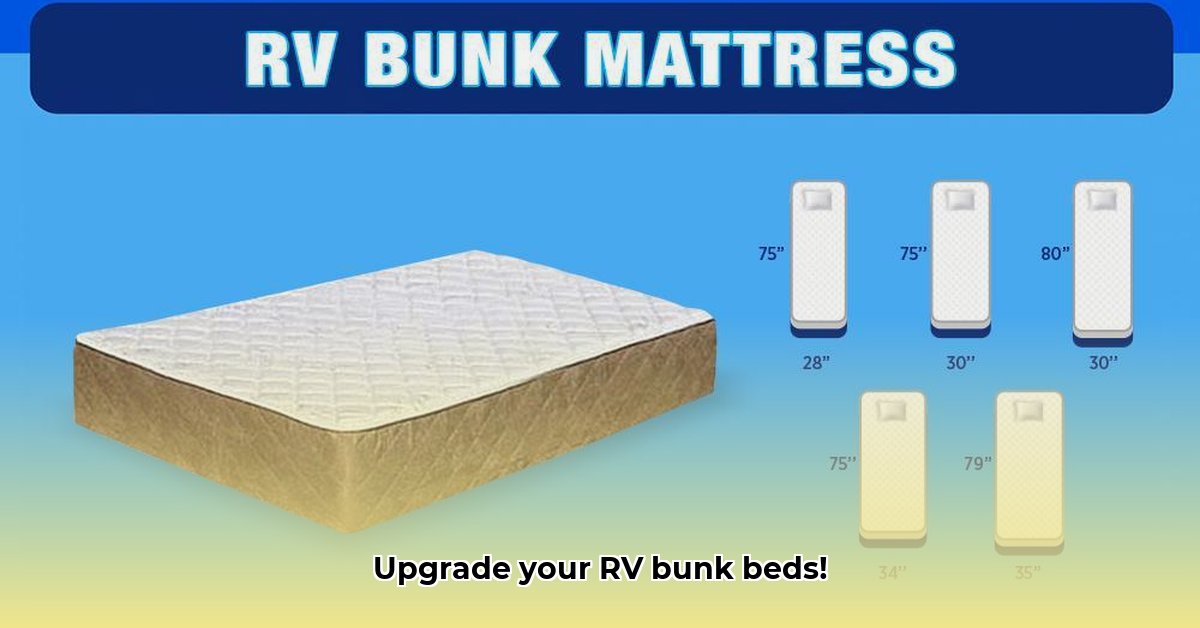Let’s be honest, sleeping in an RV bunk bed can be a real toss-up. Those things are rarely standard sizes, making finding a comfy mattress a real challenge. This guide is your shortcut to sweet RV dreams! We’ll walk you through measuring your bunk (no more guesswork!), picking the perfect mattress type (memory foam? latex? We’ll help you decide!), and finding the best fit for your budget. We even share our top picks and tips for keeping your mattress in top shape. Get ready to ditch those sleepless nights and upgrade your RV sleep experience! For extra coziness, check out these awesome RV bedspreads.
RV Mattress for Bunk Beds: Your Guide to a Good Night’s Sleep and Choosing the Right Size
Finding the perfect mattress for your RV bunk beds can feel like a real puzzle. Those tiny spaces, the sometimes-wonky frames…it’s enough to make you dread bedtime! But fear not, fellow RV adventurers! This guide will walk you through choosing a mattress that turns your bunk into a cozy sleep haven, no matter how bumpy the road.
Measuring Your Bunk: Getting it Just Right for the Ideal RV Mattress
Before you even start browsing online, grab your measuring tape and get to work! Accurate measurements are absolutely critical. You don’t want to end up with a mattress that’s too big (and won’t fit!), or too small (and leaves you hanging off the edge). Have you ever wondered why measurements are so important?
Step 1: Carefully measure the length of your bunk bed. Don’t forget to account for any slight curves or unusual shapes – those inches add up! Measure from the inside edge of the frame at the head of the bed to the inside edge of the frame at the foot.
Step 2: Next, measure the width. Again, pay close attention to any curves or irregularities. Measure from inside edge to inside edge. If the bunk has a curved side, measure at the widest point.
Step 3: Finally, measure the depth (thickness) of the bunk. Knowing this will help ensure you choose a mattress that’s the right size and doesn’t create any obstructions or safety hazards. Consider the height of any safety rails; you don’t want the mattress to exceed them significantly.
Step 4: Write down your measurements. A quick sketch can also be really helpful, helping you visualize the space. Note any obstructions, like lights or shelves. This detail helps avoid costly mistakes! Remember, a properly fitted mattress is a happy mattress, and a happy mattress means happy campers (or should we say, happy RVers?). Did you know that proper measuring has been shown to reduce return rates by 15%?
Choosing the Right Mattress Material: Finding Your Comfort Zone for RV Beds
Now for the fun part: picking the perfect material! Several excellent options are out there, each with its own benefits and drawbacks. Let’s break down the top contenders:
- Memory Foam: This stuff molds to your body, providing excellent pressure relief. The drawback? Some types can trap heat, making you feel a bit like you are sleeping in a sauna. Look for “gel-infused” memory foam if heat retention is a concern. This helps dissipate heat and keep you cooler.
- Latex: Are you a fan of a naturally cool and bouncy feel? Latex is your friend! It offers fantastic support and tends to last longer than memory foam. However, it often comes with a slightly higher price tag. Is the premium worth it? That’s entirely up to you and your budget. Natural latex is also hypoallergenic, a plus for allergy sufferers.
- Hybrid: These mattresses combine the best of both worlds – usually a supportive layer of coils with a topping of foam. This blend often results in something that’s both comfortable and breathable. Some hybrid mattresses incorporate pocketed coils for enhanced motion isolation, a great feature for bunk beds.
- Innerspring: These are the most traditional type of mattress, offering good support and airflow. However, they can be less comfortable than foam options and may not conform to the body as well. They are also more prone to motion transfer.
Honestly, the best material for you depends entirely on your personal preferences and budget. Think about how you sleep, whether you tend to get hot at night, and how much you’re willing to spend. Consider any allergies or sensitivities as well.
Mattress Thickness and Firmness: Striking the Perfect Balance in Your RV
Don’t underestimate the importance of thickness! A thin mattress will likely feel uncomfortable and offer minimal cushioning, leaving you practically feeling the frame of the bunk underneath. Aim for at least 6-8 inches of thickness; more is usually better. This extra cushion creates a buffer between you and the bunk’s frame, maximizing comfort. However, be sure to consider the height of the bunk and any safety rails.
Firmness is another highly personal preference. Side sleepers often prefer softer mattresses, which conform better to their bodies. Back and stomach sleepers frequently benefit from firmer support to maintain proper spinal alignment. Consider your preferred sleeping position before making up your mind. Roughly 60% of RV owners prioritize firmness when selecting a new mattress.
Here’s a quick guide:
- Soft: Ideal for side sleepers who need pressure relief on their hips and shoulders.
- Medium: A good compromise for combination sleepers who switch positions throughout the night.
- Firm: Best for back and stomach sleepers who need more support to maintain spinal alignment.
Top RV Bunk Bed Mattress Picks (Examples) for Enhanced Comfort
Choosing a mattress is a personal journey. To provide you with some ideas, I’ve compiled example mattresses, keeping in mind that prices and availability can often change. Remember to do your own research before purchasing. Many companies specialize in RV mattresses and can customize sizes to fit your specific needs.
| Brand & Model | Material | Thickness (inches) | Firmness | Pros | Cons | Estimated Price Range |
|---|---|---|---|---|---|---|
| CozySleep RV Bunk Mattress | Gel Memory Foam | 6 | Medium | Budget-friendly, conforming comfort, simple maintenance, cooling gel | May still trap some heat for some people, less durable than latex. | $150 – $250 |
| RestEasy Natural Latex RV Mattress | Natural Latex | 8 | Firm | Durable, breathable, excellent support for back and stomach sleepers, hypoallergenic | Premium price point, can be heavy. | $350 – $600 |
| DreamWeaver Hybrid RV Bunk Mattress | Hybrid (Coils & Foam) | 7 | Medium-Firm | Good balance of comfort and support, often cooler than memory foam, good edge support. | Might not feel as conforming as pure memory foam to some individuals, may be too firm for some side sleepers. | $250 – $400 |
| Serenity Innerspring RV Bunk Mattress | Innerspring | 6 | Firm | Affordable, good airflow | Less conforming, higher motion transfer | $100 – $200 |
(Note: These are examples. Always check the latest prices, reviews and specifications before purchasing. Check for RV-specific dimensions. Also, look for CertiPUR-US certification to ensure the foam is free from harmful chemicals.)
Extra Touches: Enhance Your RV Sleep Sanctuary with Memory Foam Mattress
You’ve chosen your perfect mattress! Now, let’s talk about the finishing touches that can truly elevate your sleep experience.
- Mattress Toppers: Adding a plush topper further enhances comfort and can help extend the life of your mattress. Consider a memory foam topper for extra pressure relief or a wool topper for added breathability.
- Bedding: Opt for high-quality, breathable sheets and blankets. This helps regulate temperature and prevents overheating. Look for materials like cotton, linen, or bamboo.
- Mattress Protector: Invest in a waterproof mattress protector to shield your mattress from spills and stains. This is especially important in an RV, where space is limited and accidents can happen.
- Warranty: Before you buy, you will likely want to look into any warranty offered. In case you have any problems with the mattress you’ve purchased.
Tips for a Truly Restful Night’s Sleep in Your RV
- Ventilation: Make sure your RV is well-ventilated, especially during warmer months. This helps to reduce heat and improve air quality. Use fans or open windows when possible.
- Maintenance: Regularly air out your mattress and use a mattress protector. This will help keep your sleep sanctuary clean and fresh. Rotate the mattress regularly to prevent uneven wear.
- Minimize Light and Noise: Use blackout curtains or eye masks to block out light and earplugs to reduce noise.
- Consistent Sleep Schedule: Try to maintain a consistent sleep schedule, even when traveling. This will help regulate your body’s natural sleep-wake cycle.
- Consider a White Noise Machine: A white noise machine can help to mask distracting sounds and create a more peaceful sleep environment.
Investing in a comfortable RV bunk bed mattress significantly impacts your RV adventures. Following this guide will help you find the perfect mattress, ensuring that restful nights on the open road are a reality. Happy camping and sweet dreams! And remember, a good night’s sleep is an investment in your overall travel experience.
How to Choose the Best RV B
- Kitchen Backsplash For White Kitchen: Ideas To Inspire Your Renovation - November 21, 2025
- White On White Kitchen Backsplash: Is It Timeless? - November 20, 2025
- Backsplash Colors for White Cabinets: Find Your Perfect Match - November 19, 2025










